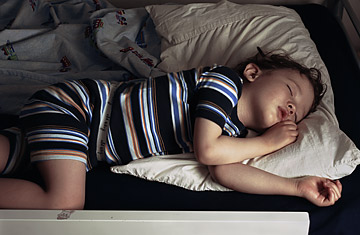
New lessons from 100 years of bedtime battles
Here's what a child's bedtime looks like to couples expecting their first baby: the nursery is softly lit, the child is sweetly sleepy, the last page of Goodnight Moon has been read. After that comes the final tuck-in, the gentle kiss and, finally, the quiet tiptoe out of the room.
So how often does this happen after the kids arrive? The answer--rounding to the closest zero--is, well, zero. Or at least that's the way it seems. Wartime over bedtime is as fixed a part of childhood as teething and potty training, except that it goes on much, much longer and is much, much more exasperating. It's not for nothing that last year's exquisitely titled faux children's book Go the F--- to Sleep reached No. 1 on the Amazon.com best-seller list a month before it was released. But the battle to get kids down for the night does not just drive parents to distraction; it causes them to worry. Children of all ages need a fixed amount of sleep every night, right? So what happens if your kids consistently fail to get theirs?
This is surely not the first generation of parents to fret about these things. It's not even the first generation to believe that all the new technology surrounding--and overstimulating--their kids is making the problem worse than it's ever been. According to a recent study from the University of South Australia, the issue has been debated for at least 100 years, and while eras may pass and the recommended hours of sleep may change, one thing remains stubbornly consistent: kids do not get as much as professionals think they should. The question is whether the professionals are right.
The Australian study, published in the journal Pediatrics in February, began as a straight-ahead exercise in scientific spelunking, with investigators looking for every population-wide paper about kids and sleep duration published from the end of the 19th century through 2009. They discovered more than 200 of them--with one French study dating all the way back to 1897--and two trends were immediately evident.
First, the amount of sleep recommended for every age group has declined steadily over time, dropping an average of 0.71 minutes per year. Now, 0.71 minutes is only about 43 seconds, which does not amount to much over the course of a night. But over 112 years, that adds up to one hour and 20 minutes--and that's not nothing. At the same time, the amount of sleep that kids were getting was keeping almost perfect pace, dropping about 0.73 minutes per year. No matter how low the recommended-sleep bar gets, children have never quite cleared it.
Another constant: societal hand wringing over children's lack of sleep and a tendency to blame the hectic pace of modern living. As far back as the late 1800s, an editorial in the British Medical Journal attributed increasing sleeplessness to the stress and hurry of everyday life, made worse by the gaslights and trolley cars suddenly filling the streets. In 1905 one study noted that "this is a sleepless age and more and more ... we are turning night into day." Says Tim Olds, a professor of health and sciences at the University of South Australia and the senior author of the new study: "Throughout the 100-year period, we have been blaming whatever the new technology is--radio, TV, the Internet. Information is coming in so fast that we never wind down."
